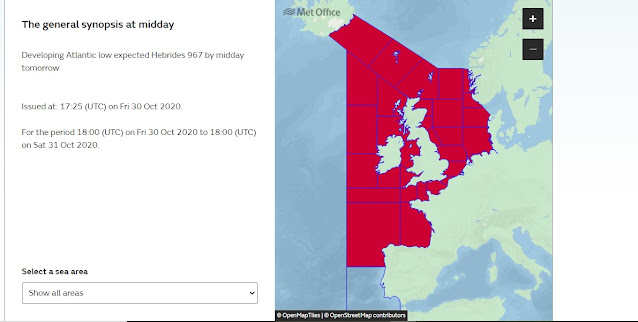 |
| copy of Met Office shipping forecast map - acknowledgement and thanks to Met Office |
An adult (or 2cy) Sabine's Gull flew through with a flock of Kittiwake 'mid-far' distance at 08:40. A small adult (male?) pale phase Pomarine Skua spent a few minutes close in and at one point flew over the seawall. A European Storm-petrel flew in toward the seawall at 09:50. And the last major highlight was after the rains had passed, a Sooty Shearwater passed at 10:55 some way out. The count of 598 Kittiwake was big and only surpassed about a dozen times here in recorded history. By contrast, 44 Gannet and single-figures each of Razorbill and Guillemot were remarkably poor. Also, 21 Common Scoter, seven Great Northern Diver, five Red-throated Diver (plus a diver sp.) and a Great Skua. Small number of Oystercatcher, Curlew, a Bar-tailed Godwit and small number of mixed gulls struggled through, including an adult Mediterranean Gull.
Conditions flipped late morning to become pleasantly calm with warm sunshine. Perhaps due to no burning today, wooded areas were productive with a roaming flock that contained most of the 23 Blue Tit, 15 Long-tailed Tit, three Great Tit and two Coal Tit; the individual seen well was the britannicus British-race. Also four Chiffchaff, two Goldcrest and a Firecrest. A couple of Chaffinch and single Great Spotted Woodpecker and Bullfinch were also recorded.
Most finches appear to have migrated a few days ago and there remained only about 20 Goldfinch, six Greenfinch and a Siskin flew over. On the Main Pond, a Mallard and a Little Grebe.
The incoming evening high tide brought in a four-figure count of Wigeon but still no sign of the American Wigeon. Some counts were conducted and the best of these was 154 Turnstone, the highest count here since January 1989, many foraged on piles of green algae that have accumulated on mudflats out from Railway Saltmarsh. Larger counts regularly occur at their main roost on the old harbour wall at Starcross, located a little to the north of the recording area. Other counts were 359 Dark-bellied Brent Goose with two Pale-bellied Brent Goose with them; 243 Redshank, c.215 Dunlin, 184 Teal, 160 Great Black-backed Gull (including ten on the seawatch), c.40 Knot, 37 Curlew (including 13 on the seawatch), 35 Shelduck, 18 Mute Swan, c.13 Ringed Plover, seven Sanderling, five Greenshank, another four Mallard, four Lesser Black-backed Gull (including two on the seawatch), three Little Egret, two Grey Heron, two Black-tailed Godwit; also the Slavonian Grebe, the drake Eider and single Great Crested Grebe, another Little Grebe, Pintail, Red-breasted Merganser, Kingfisher and presumably the same Whimbrel. Earlier in the day, two Peregine hunted over the estuary.
In the evening around The Bight, the pre-roost flock reached 22 Linnet; a typical count of late. Of the two or three Rock Pipit present, one was the colour-ringed Scandinavian Rock Pipit.
Wildlife news: brief views of a large, butter-white and black checkered-patterned butterfly that flew out across the beach and lost from view looked very interesting but, sadly, was lost and unidentified. More standard fayre were a Speckled Wood along a wooded edge and a Migrant Hawker over the Main Pond.










